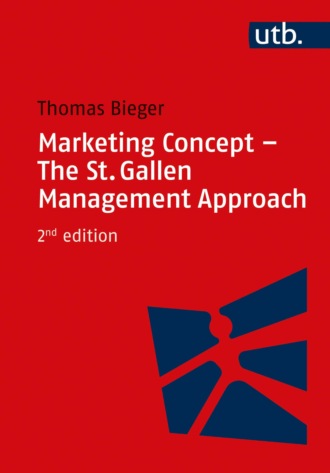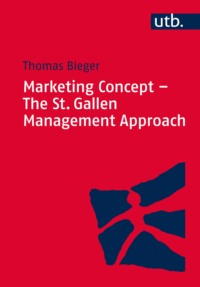
Полная версия
Marketing Concept - The St. Gallen Management Approach

utb 4464

[1] Eine Arbeitsgemeinschaft der Verlage
Brill | Schöningh – Fink · Paderborn
Brill | Vandenhoeck & Ruprecht · Göttingen – Böhlau
Verlag · Wien · Köln Verlag Barbara Budrich · Opladen · Toronto
facultas · Wien
Haupt Verlag · Bern
Verlag Julius Klinkhardt · Bad Heilbrunn
Mohr Siebeck · Tübingen
Narr Francke Attempto Verlag – expert verlag · Tübingen
Ernst Reinhardt Verlag · München
transcript Verlag · Bielefeld
Verlag Eugen Ulmer · Stuttgart
UVK Verlag · München
Waxmann · Münster · New York
wbv Publikation · Bielefeld
Wochenschau Verlag · Frankfurt am Main
[3] Thomas Bieger
Marketing Concept – The St. Gallen Management Approach
2nd, revised edition
Haupt Verlag
[4] Thomas Bieger, Prof. Dr., full professor of Business Administration with special emphasis on tourism. Dean of the Faculty of Management at the University of St. Gallen (2003–2005). President of the University of St. Gallen (2011–2020).
The second edition of this book is congruent with the third edition of the German version (Das Marketingkonzept im St. Galler Management-Modell):
978-3-8252-5091-1 (Print),
978-3-8463-5091-1 (E-Book)
2nd edition: 2021
1st edition: 2015
detailed bibliographic data is available at the
Deutsche Nationalbibliothek: http://dnb.dnb.de
All rights reserved.
Copyright © 2021 Haupt
This book, including all of its parts, is protected by copyright. Every kind of use beyond the limits of the narrow restrictions of the law of copyright is not allowed without the explicit consent of the editor. Noncompliance to these restrictions are inadmissible and criminal. This applies equally for the duplication, translation, microfilming as well as for digital storage and subsequent processing of the book or any of its parts.
Cover design: Atelier Reichert, Stuttgart
www.haupt.ch
UTB number: 4464
ISBN 978-3-8252-5752-1 (Print)
ISBN 978-3-8463-5752-1 (E-Book)
Preface to the 1st edition
[5] The St. Gallen Management Model created a comprehensive orientation framework for the management of companies and organizations of all kinds. Business processes play a special role in the model. They enable the real core function that justifies the existence of a company or organization, which is to deliver goods and services to third parties, usually for money.
This book is guided by the St. Gallen Management Model and, therefore, focuses on business processes. It also follows the approach of the marketing concept as an overall planning and designing approach, not just for marketing, but for all business functions. The content of this book thus offers an introduction to marketing as well as the design of business processes as a whole.
The book addresses two targets and thus two target groups: To begin with, it serves as a basis for the introduction to business administration as part of the Marketing Management curriculum during the Assessment Year at the University of St. Gallen. It covers the subject areas of marketing, performance and innovation.
At the same time, it is designed to appeal to the public at large as a basic text for study or practice. It serves as an introduction to or an update of knowledge in the areas of marketing and performance provision/performance process, while also presenting the marketing concept as a pragmatic approach of thought and action used by generations of (marketing) managers.
The outline of the book follows the usual structure of a marketing concept and is also the basis for the division into six lecture blocks at the University of St. Gallen:
1. Business Processes and Marketing Concept within the St. Gallen Management Model — an Introduction
2. Market Analysis — from a Static to a Dynamic Point of View
3. Marketing Strategy — from Market Segmentation to Positioning Strategy
[6]
4. Marketing Tool Application 1: Product Design and Performance
5. Marketing Tool Application 2: Pricing, Promotion and Distribution
6. Innovation and Controlling — Meta Processes of Business Activity
As a topical guide for decision-makers and as teaching material on a university level, the book’s aim is not maximum depth and the transfer of detailed knowledge. Rather, the goal is contextual knowledge and new perspectives in thinking. As a textbook, it primarily points out key sources.
At the same time, the integrative approach cultivated at the University of St. Gallen is taken into account. This results from a focus on the St. Gallen Management Model as well as from methodically including the approach of networked thinking in the market-analysis section and by cross-referencing other disciplines, especially economics and law.
In part, this book is based on principles, concepts and sections of the book “Einführung in die Managementlehre” by Dubs, Euler, Rüegg-Stürm and Wyss (2009), which was used previously as a textbook at the University of St. Gallen and to which the author also contributed. The following authors also worked on the previous book in the area of business processes: Günther Schuh, Thomas Friedli, Torsten Tomczak, Fritz Fahrni and Sven Reinecke.
I wish to thank Mrs. Margareta Brugger for transcribing the manuscript, student assistant Jessica Schulten-Baumer for revising and editing the text, and my wife Barbara for critical reading. I also thank Samuel Heer for his valuable support, not only in revising this book but also in our efforts to offer actual and method-oriented lectures on the Assessment level of the University of St. Gallen. I also thank my colleagues o. Univ. Prof. Dr. Johannes Rüegg-Stürm and assistant professor Dr. Simon Grand for stimulating discussions, the good cooperation, and many valuable inputs.
May 2015
Thomas Bieger
Preface to the 2nd edition
[7] After six years of use in the first semester at the University of St. Gallen, a new edition of the “Marketing Concept” became necessary. This second edition integrates the latest developments of the St. Gallen Management Model as well as some important developments of the discipline, such as business model concepts.
I would like to thank Simon Kuster for his care in handling the process and his contributions. Thanks also go to Pietro Beritelli and Jay Binneweg for providing feedback on the English version. The second edition of this book is congruent with the third edition of the German version (Das Marketingkonzept im St. Galler Management-Modell).
July 2021
Thomas Bieger
Table of Figures
[13] Fig.1: Example of a value-creation chain
Fig.2: Enterprise systems, value-creation networks, value-creation chains
Fig.3: Value-creation chain, transaction interfaces and enterprise
Fig.4: Management cycle according to Fayol
Fig.5: First generation of the St. Gallen Management Model
Fig.6: Stakeholders of an enterprise
Fig.7: St. Gallen Management Model, latest development of the third generation, business perspective on organizational value creation
Fig.8: Triple bottom line
Fig.9: Contents of the three meaning horizons
Fig. 10: Primary processes or business processes, according to Porter
Fig. 11: Business processes and markets
Fig. 12: Perceived customer value
Fig. 13: Conceptual relation between customer value, value creation and enterprise value; as an example of a profitability link according to Larivière, 2008
Fig. 14: Calculation of value creation
Fig. 15: Structure of business processes
Fig. 16: Service-provision process as a value-creation chain
Fig. 17: Business process: goods and services
Fig. 18: Service chain in incoming tourism
Fig. 19: The customer buying cycle
Fig. 20: Structure of a brand according to Aaker (1992) using the HSG as an example
Fig. 21: Five-phase product life-cycle model
Fig. 22: Development of marketing
Fig. 23: Marketing concept
Fig. 24: Customer system
Fig. 25: Benefits of long-term customer commitment
[14]
Fig. 26: Transaction relationships in e-commerce
Fig. 27: Composition of demand
Fig. 28: Purchase decision for holiday travels
Fig. 29: SOR behavioral model
Fig. 30: Theory of planned behavior
Fig. 31: Market sizes
Fig. 32: Importance of specific information sources in tourism
Fig. 33: Travel motivation (1+ overnights)
Fig. 34: Types of trends
Fig. 35: Development of trends
Fig. 36: Systematic analysis of new trends using the example of scooters
Fig. 37: Example of a simplified tourism system and its dynamics
Fig. 38: Market analysis as part of the marketing concept
Fig. 39: Matrix of a SWOT analysis
Fig. 40: Strength and weakness analysis of a typical Swiss destination
Fig. 41: Demand trends and opportunities and threats deduced from them for a Swiss destination
Fig. 42: Marketing strategy within the marketing concept
Fig. 43: Goal hierarchy in marketing (exemplary)
Fig. 44: From market segmentation to differentiation
Fig. 45: Optimal segmentation
Fig. 46: Multi-stage market segmentation for the skiing market
Fig. 47: Statistical market segmentation by motives with the help of cluster analyses
Fig. 48: Ways of illustrating brand positioning
Fig. 49: Industry environment conditions and basic strategies for customer acquisition
Fig. 50: Why customer retention pays off
Fig. 51: The main tasks of customer retention
Fig. 52: Overview of marketing tools
Fig. 53: Detailed planning of a marketing mix — marketing plan
Fig. 54: From customer value to value of the customer
Fig. 55: Conception levels for the product
Fig. 56: Goods and services typology
Fig. 57: Alternative decisions depending on program policy
Fig. 58: Basic structure of the physical performance process
Fig. 59: Basic structure of performance process
Fig. 60: Possible roles of companies in a value chain
Fig. 61: Types of business operations
[15]
Fig. 62: Characteristic features of services
Fig. 63: Demarcation between service and material good
Fig. 64: Service chain in incoming tourism — destination point of view
Fig. 65: Individual service chain
Fig. 66: Service chain in outgoing tourism — perspective travel as a whole and travel agency
Fig. 67: Concept of a service chain from a customer’s perspective
Fig. 68: Demand curve as an aggregation of individual preferences
Fig. 69: Price effect elasticities
Fig. 70: Assimilation contrast theory
Fig. 71: Price determination
Fig. 72: Yield management systems
Fig. 73: Yield management for booking systems
Fig. 74: Strategic distribution
Fig. 75: Example: Sales channel in tourism
Fig. 76: Distribution system
Fig. 77: Development prospects in distribution
Fig. 78: General communication process and marketing communication process
Fig. 79: Communication organization
Fig. 80: Communication tools
Fig. 81: Examples for tool goals in marketing
Fig. 82: Detailed planning marketing mix — marketing plan
Fig. 83: Marketing mix within the buying cycle
Fig. 84: Dimensions of business models
Fig. 85: Interaction of business model components of airlines
Fig. 86: Management function according to Fayol
Fig. 87: Possible indicators for measuring marketing’s success during a relaunch
Fig. 88: Goal hierarchy and controlling
Fig. 89: Product-specific multi-level contribution-accounting analysis
Fig. 90: Swiss International Air Lines controlling structure
Fig. 91: Return on investment between the poles of innovation push and pull
Fig. 92: The innovation process
Fig. 93: Required innovation according to industry and goods
Fig. 94: Innovation cube for the classification of strategic directions of impact
Fig. 95: Marketing concept
Конец ознакомительного фрагмента.
Текст предоставлен ООО «ЛитРес».
Прочитайте эту книгу целиком, купив полную легальную версию на ЛитРес.
Безопасно оплатить книгу можно банковской картой Visa, MasterCard, Maestro, со счета мобильного телефона, с платежного терминала, в салоне МТС или Связной, через PayPal, WebMoney, Яндекс.Деньги, QIWI Кошелек, бонусными картами или другим удобным Вам способом.


